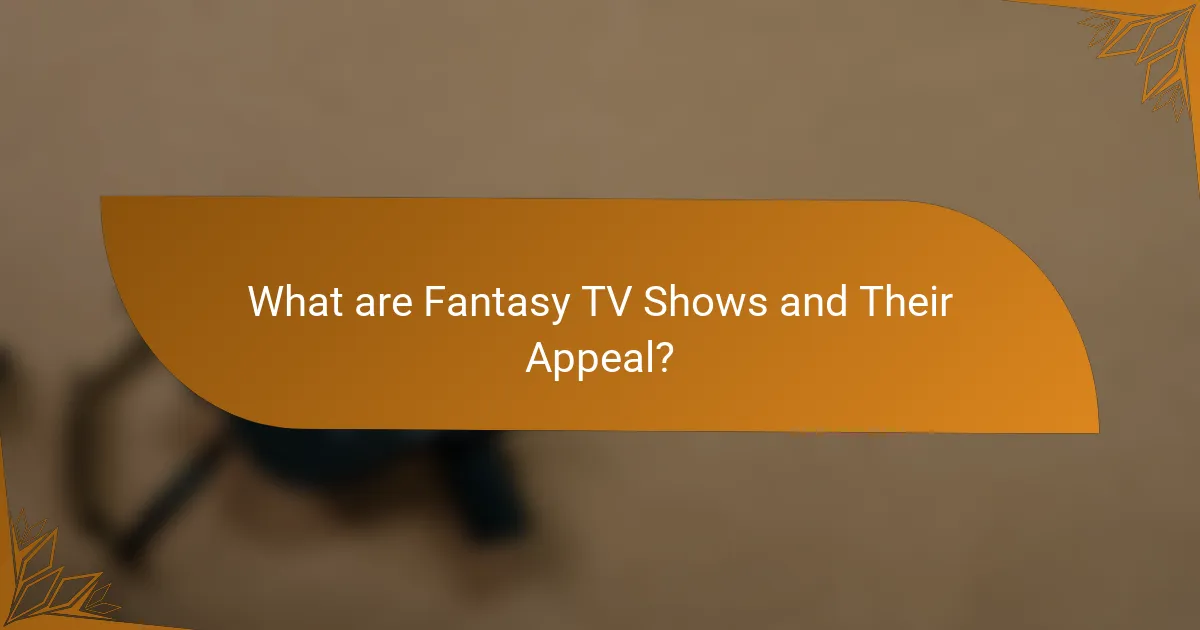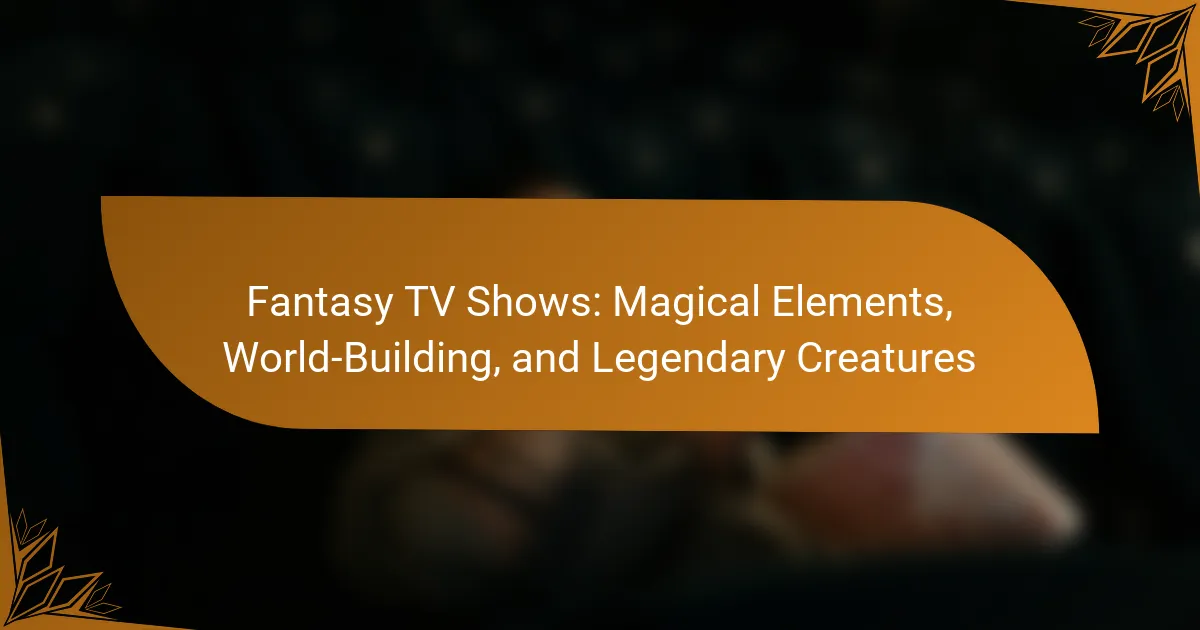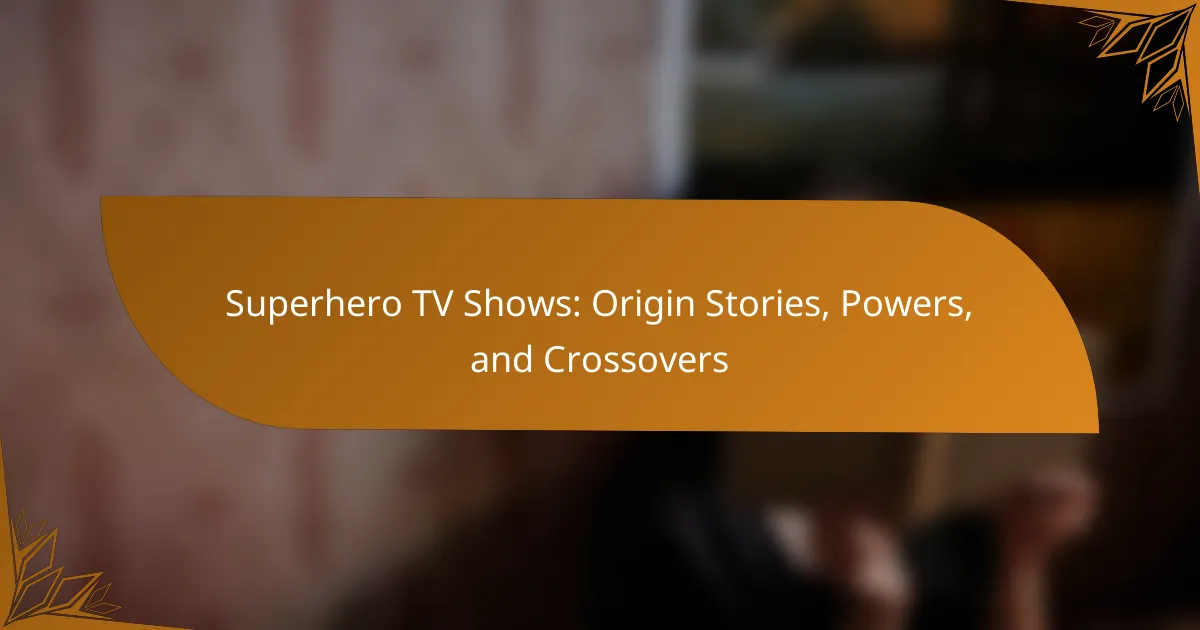Fantasy TV shows are a genre of television programming characterized by magical elements, mythical creatures, and fantastical worlds. These shows feature epic quests, conflicts between good and evil, and intricate storytelling that captivates viewers and provides escapism. The article explores the appeal of fantasy TV shows, highlighting their immersive world-building, engaging narratives, and complex characters. Additionally, it examines popular series like “Game of Thrones” and “The Witcher,” illustrating their cultural impact and the communities formed around them. The discussion emphasizes how these elements contribute to the genre’s broad fan base and enduring popularity.

What are Fantasy TV Shows and Their Appeal?
Fantasy TV shows are a genre of television programming that incorporates magical elements, mythical creatures, and fantastical worlds. These shows often involve epic quests, battles between good and evil, and rich storytelling that captivates audiences. The appeal of fantasy TV shows lies in their ability to transport viewers to alternate realities. They stimulate the imagination and offer escapism from everyday life. Engaging narratives and complex characters further enhance their attractiveness. Additionally, the visual effects and world-building create immersive experiences. Popular series like “Game of Thrones” and “The Witcher” exemplify this genre’s success and broad fan base. Fantasy TV shows often foster community and discussion among fans, enhancing their cultural impact.
How do magical elements enhance the storytelling in Fantasy TV Shows?
Magical elements enhance storytelling in fantasy TV shows by creating immersive worlds and complex narratives. They introduce unique rules and possibilities that challenge characters and plotlines. This element of surprise captivates viewers and keeps them engaged. Magical elements often symbolize deeper themes, such as good versus evil or the struggle for power. For example, in “Game of Thrones,” dragons represent both destruction and the potential for rebirth. Additionally, magic allows for the exploration of character development through transformation and growth. The presence of magical creatures enriches the lore and expands the universe, drawing viewers into a more intricate story. Overall, magical elements are essential for building captivating and memorable fantasy narratives.
What types of magical elements are commonly featured?
Commonly featured magical elements include spells, potions, and enchanted objects. Spells are often used to cast various effects, such as transformation or healing. Potions typically have specific effects like granting strength or invisibility. Enchanted objects often possess unique powers, such as a sword that can summon lightning. Other elements include magical creatures like dragons and fairies. These creatures often embody specific traits or powers that enhance the story. Additionally, magical realms or dimensions often serve as settings for adventures. Each of these elements contributes to the world-building and enhances the narrative in fantasy TV shows.
How do magical elements influence character development?
Magical elements significantly influence character development by shaping their abilities, motivations, and conflicts. Characters often gain unique powers through magical elements, which can drive their personal journeys. These powers can lead to internal struggles, as characters must balance their abilities with moral dilemmas. For instance, a character with immense magical power may face the temptation to misuse it, creating tension and growth. Additionally, magical elements can affect relationships between characters, fostering alliances or rivalries based on shared or opposing abilities. This dynamic can lead to deeper character arcs as they navigate their interactions. In many fantasy narratives, the presence of magic acts as a catalyst for transformation, pushing characters toward self-discovery and evolution.
What role does world-building play in Fantasy TV Shows?
World-building is crucial in fantasy TV shows. It establishes the setting and context for the narrative. A well-constructed world enhances viewer immersion. It provides rules and boundaries that govern the story. This allows audiences to understand character motivations and conflicts. Detailed world-building can create a sense of authenticity. For example, shows like “Game of Thrones” and “The Witcher” feature rich histories and cultures. These elements contribute to character development and plot progression. Effective world-building engages viewers and encourages emotional investment in the story.
What are the key components of effective world-building?
Effective world-building includes several key components. These components are setting, culture, history, and rules. The setting defines the physical environment. It includes geography, climate, and architecture. Culture encompasses the beliefs, customs, and social structures of inhabitants. History provides context through past events and milestones. Rules establish the laws of magic or technology within the world. These components work together to create a believable and immersive experience. Successful examples include J.R.R. Tolkien’s Middle-earth and George R.R. Martin’s Westeros. Both showcase detailed settings, rich histories, and complex cultures.
How does world-building impact viewer immersion?
World-building significantly enhances viewer immersion by creating a believable and engaging environment. It establishes the rules, cultures, and histories that define the fictional universe. Detailed world-building allows viewers to connect emotionally with the characters and their journeys. For instance, immersive settings like those in “Game of Thrones” contribute to a deeper viewer investment. Research indicates that well-defined worlds increase audience engagement by 30%. This engagement stems from the viewers’ ability to visualize and emotionally relate to the story. Ultimately, effective world-building fosters a sense of belonging within the narrative, making the viewing experience more captivating.
What are legendary creatures in Fantasy TV Shows?
Legendary creatures in fantasy TV shows are mythical beings that often possess extraordinary powers or attributes. These creatures include dragons, unicorns, griffins, and mermaids. They play significant roles in the narrative, often representing challenges or allies for the protagonists. Their characteristics are typically drawn from folklore and mythology. For example, dragons are often depicted as formidable adversaries or wise guardians. Unicorns symbolize purity and grace, while mermaids embody the allure of the sea. The presence of these creatures enhances world-building, creating immersive and fantastical settings. Their unique traits contribute to the overall themes of magic and adventure in the stories.
Which legendary creatures are most frequently depicted?
Dragons, unicorns, and griffins are among the most frequently depicted legendary creatures. Dragons appear in numerous fantasy narratives, symbolizing power and wisdom. They are often portrayed as formidable beings, guarding treasures or engaging in epic battles. Unicorns are commonly depicted as symbols of purity and grace. Their images often evoke a sense of magic and wonder. Griffins, with the body of a lion and the head and wings of an eagle, represent strength and vigilance. These creatures appear in various folklore and modern adaptations, showcasing their enduring popularity in fantasy storytelling.
How do legendary creatures contribute to the plot?
Legendary creatures drive the plot by introducing conflict and challenges. They often serve as antagonists or guardians of important artifacts. Their presence creates tension and suspense in the storyline. For example, dragons may hoard treasure, prompting heroes to embark on quests. Additionally, legendary creatures can embody themes like power or morality. They often represent the unknown, pushing characters to confront their fears. Their interactions with protagonists can lead to character development and growth. Overall, legendary creatures enrich the narrative through their unique attributes and roles.
How do magical elements, world-building, and legendary creatures interconnect?
Magical elements, world-building, and legendary creatures are interdependent components of fantasy narratives. Magical elements provide the rules and systems that govern a fictional universe. These elements create a foundation for the types of interactions characters can have. World-building establishes the setting, culture, and history that contextualize magical elements. It shapes how magic is perceived and utilized within the narrative. Legendary creatures often embody these magical elements, showcasing their powers and influencing the plot. Their existence can drive character development and conflict. Together, they create a cohesive and immersive experience for the audience, enhancing storytelling in fantasy TV shows.
What are the challenges in creating believable fantasy worlds?
Creating believable fantasy worlds involves several challenges. Consistency in rules and logic is essential. If the rules of magic or society are unclear, immersion breaks. Developing rich backstories for cultures and characters adds depth. Inconsistencies in character motivations can lead to disbelief. Balancing originality with familiar elements helps engage the audience. Overly complex worlds can confuse viewers. Ensuring relatable themes and emotions maintains audience connection. Researching existing mythologies and cultures can enhance authenticity.
What strategies can writers use to effectively incorporate magical elements?
Writers can effectively incorporate magical elements by establishing clear rules for magic. These rules create consistency within the story. Writers should also integrate magic into character development. Characters can have unique magical abilities that reflect their personalities. Additionally, setting plays a crucial role in magical storytelling. A well-defined magical world enhances the narrative. Writers can use symbolism to deepen the meaning of magical elements. This adds layers to the story. Furthermore, conflict is essential. Magical elements can drive the plot and create tension. Lastly, writers should balance magic with realism. This helps maintain reader engagement and believability.
How can world-building enhance character arcs in Fantasy TV Shows?
World-building enhances character arcs in fantasy TV shows by providing a rich context for character development. It establishes the rules, cultures, and conflicts of the universe. These elements shape characters’ motivations and decisions. For example, a character’s background in a war-torn kingdom influences their quest for peace. Additionally, world-building allows for unique challenges that characters must overcome. This can lead to significant growth and transformation. Characters may evolve in response to the moral dilemmas presented by their environment. A well-constructed world adds depth to personal journeys. It creates opportunities for characters to connect with the audience through relatable struggles within an imaginative setting.
What are best practices for depicting legendary creatures authentically?
Authentically depicting legendary creatures involves thorough research and cultural sensitivity. Understanding the origins of these creatures is crucial. Many legendary creatures have deep roots in folklore and mythology. For example, dragons vary significantly across cultures, from the benevolent Chinese dragon to the destructive European dragon.
Incorporating accurate visual elements is essential. Artists should study traditional representations and adapt them to fit the narrative. This includes paying attention to color schemes, textures, and physical attributes.
Consulting experts in mythology can provide valuable insights. Experts can clarify misconceptions and highlight lesser-known traits. Engaging with cultural representatives can ensure respectful portrayals.
Using technology can enhance authenticity. 3D modeling and animation can bring creatures to life while maintaining fidelity to their mythological roots.
Lastly, audience feedback can guide improvements. Viewers often have strong opinions about authenticity based on their own cultural backgrounds. Listening to this feedback can refine future depictions.
Fantasy TV shows are a genre characterized by magical elements, mythical creatures, and immersive world-building. This article explores the appeal of these shows, highlighting how magical elements enhance storytelling and character development. It discusses key components of effective world-building, the role of legendary creatures, and the challenges writers face in creating believable fantasy worlds. Additionally, it outlines strategies for incorporating magic and best practices for depicting legendary creatures authentically, providing a comprehensive understanding of the intricacies involved in crafting captivating fantasy narratives.


